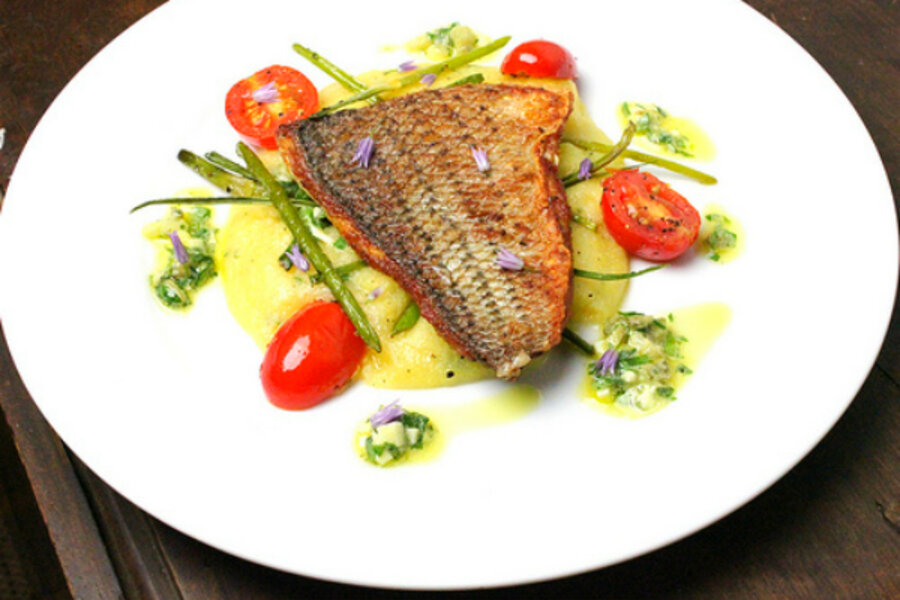Garlic scapes and pan-fried sea bass
Loading...
A few years back there was an explosion in the popularity of semi-wild springtime comestibles like morels, wild garlic, nettles and fiddlehead ferns, as if they had never existed before – and if you weren’t blogging about how amazing this annual foragable bounty was then you were either terribly gauche or just plain old-fashioned. To our credit, we did do our best to surf this trend and did at least one post featuring morels, even going so far as to dig up a clump of wild garlic we found growing in our local NYC park and transplant it in a pot on our balcony, but it never really caught on with us.
In truth this is probably because we live in Brooklyn where the closest things to wild are the noises coming out of the adjacent tenement building on a warm summer night, so that all these wild spring greens are only available from the farmer’s market, which somehow defeats the object.
Unknowingly, last fall, just like the previous year we planted regular garlic from the grocery store in our small weedy plot out back and thought nothing more of it. With the mild weather, it grew throughout the winter, maturing much earlier than we had expected, so that during early May we witnessed a peculiar phenomenon. Out of each of our plants sprouted a thin, fibrous tendril, like an elongated stick insect or a witches’ finger, that shot skyward for about a foot, seemingly overnight. Realizing that we no longer needed to choose between getting fleeced by gentlemen farmers from the Hudson Valley for a pound of chewy scapes or buying groceries for the week, we harvested and sauteed them as an accompaniment to a pan-fried fillet of sea bass and some creamy polenta.
For those of you who haven’t had the pleasure of a garlic scape yet, they are (almost) worth the hype. They are like a garlicky green bean, with all the crunch of the whole bean and a delightfully mild yet pungent aroma of garlic. Most recipes call for making them into a pesto, which sounds perfectly good, too, but favors aroma over texture. Our recipe has both.
We have since harvested our fully grown garlic bulbs and only learned now that they are probably larger because we harvested the scapes which would otherwise have stolen vital plumpness and invested it into producing reproductive flowers. Happily, garlic is a peculiar, self-cloning creature that requires no pollination to reproduce, so all we need to do is save the largest of this year’s crop for planting in the fall and we should get even larger bulbs and more scapes next year.
Pan-Fried Sea Bass Fillet with Garlic Scapes and Sauce Gribiche
Serves 2
1 lb. sea bass, filleted, skin on
1 tablespoon flour or cornstarch
1/2 lb. garlic scapes, chopped into 4-6 inch lengths
2 tablespoons neutral oil for frying
For the sauce gribiche:
3 ounces cornichons, chopped finely
1 tablespoon capers, chopped finely
1/2 cup regular full-fat mayonnaise
2-3 tablespoons flat leaf parsley, chopped finely
2 smallish or 1 large hardboiled eggs, chopped finely
1/2 tablespoon of chives, chervil, and/or tarragon
a couple of squeezes of lemon juice or splashes of red wine vinegar to taste
1/2 shallot, finely minced
2 teaspoons smooth Dijon mustard
3 tablespoons extra virgin olive oil
salt and pepper to taste
Sprinkle sea bass fillet with salt and pepper and flour lightly (or cornstarch).
Heat oiled pan to medium high and cook fillets skin side down for 3 minutes, or until crispy and golden, flip gently and cook for another minute or so, until just cooked through.
Reserve fillets in a barely warm oven, and seasoning the garlic scapes with salt and pepper, saute in same pan/oil on a slightly lower heat, medium-ish, until wilted but still nice and crunchy.
Remove from pan and serve with sea bass and sauce gribiche (preparation below).
For the sauce gribiche:
Combine mustard, mayonnaise, olive oil and vinegar or lemon juice with a whisk.
Add to this chopped egg, parsley, shallot, fine herbs, capers and cornichons, and stir well.
Taste and correct seasoning. Serve with sea bass and garlic scapes, or as is common for this classic French sauce with asparagus, another springtime favorite.
Related post on We Are Never Full: Black Cod with Morels and Minty Pea Puree








